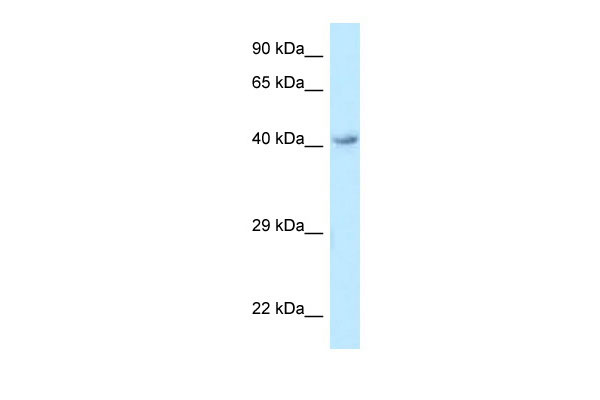O3FAR1 antibody - C-terminal region
Rabbit Polyclonal Antibody
- 产品详情
- 实验流程
Application
| WB |
|---|---|
| Primary Accession | Q5NUL3 |
| Other Accession | NM_025079, NP_079355 |
| Reactivity | Human, Mouse, Rat, Rabbit, Dog, Guinea Pig, Horse, Bovine |
| Predicted | Human, Mouse, Rabbit, Pig, Dog, Bovine |
| Host | Rabbit |
| Clonality | Polyclonal |
| Calculated MW | 40494 Da |
| Gene ID | 338557 |
|---|---|
| Alias Symbol | GPR129, GT01, MGC119984, PGR4, GPR120, O3FAR1 |
| Other Names | Free fatty acid receptor 4, G-protein coupled receptor 120, G-protein coupled receptor 129, G-protein coupled receptor GT01, G-protein coupled receptor PGR4, Omega-3 fatty acid receptor 1, FFAR4, GPR120, GPR129, O3FAR1, PGR4 |
| Format | Liquid. Purified antibody supplied in 1x PBS buffer with 0.09% (w/v) sodium azide and 2% sucrose. |
| Reconstitution & Storage | Add 50 ul of distilled water. Final anti-O3FAR1 antibody concentration is 1 mg/ml in PBS buffer with 2% sucrose. For longer periods of storage, store at 20°C. Avoid repeat freeze-thaw cycles. |
| Precautions | O3FAR1 antibody - C-terminal region is for research use only and not for use in diagnostic or therapeutic procedures. |
| Name | FFAR4 (HGNC:19061) |
|---|---|
| Function | [Isoform 2]: G-protein-coupled receptor for long-chain fatty acids (LCFAs) with a major role in adipogenesis, energy metabolism and inflammation. Signals via G-protein and beta-arrestin pathways (PubMed:22282525, PubMed:22343897, PubMed:24742677, PubMed:24817122, PubMed:27852822). LCFAs sensing initiates activation of phosphoinositidase C-linked G proteins GNAQ and GNA11 (G(q)/G(11)), inducing a variety of cellular responses via second messenger pathways such as intracellular calcium mobilization, modulation of cyclic adenosine monophosphate (cAMP) production, and mitogen-activated protein kinases (MAPKs) (PubMed:22282525, PubMed:22343897, PubMed:24742677, PubMed:27852822). After LCFAs binding, associates with beta-arrestin ARRB2 that acts as an adapter protein coupling the receptor to specific downstream signaling pathways, as well as mediating receptor endocytosis (PubMed:22282525, PubMed:24817122). In response to dietary fats, plays an important role in the regulation of adipocyte proliferation and differentiation (By similarity). Acts as a receptor for omega-3 polyunsaturated fatty acids (PUFAs) at primary cilium of perivascular preadipocytes, initiating an adipogenic program via cAMP and CTCF-dependent chromatin remodeling that ultimately results in transcriptional activation of adipogenic genes and cell cycle entry (By similarity). Induces differentiation of brown adipocytes probably via autocrine and endocrine functions of FGF21 hormone (By similarity). Activates brown adipocytes by initiating intracellular calcium signaling that leads to mitochondrial depolarization and fission, and overall increased mitochondrial respiration (By similarity). Consequently stimulates fatty acid uptake and oxidation in mitochondria together with UCP1-mediated thermogenic respiration, eventually reducing fat mass (By similarity). Regulates bi-potential differentiation of bone marrow mesenchymal stem cells toward osteoblasts or adipocytes likely by up-regulating distinct integrins (By similarity). In response to dietary fats regulates hormone secretion and appetite (By similarity). Stimulates GIP and GLP1 secretion from enteroendocrine cells as well as GCG secretion in pancreatic alpha cells, thereby playing a role in the regulation of blood glucose levels (By similarity). Negatively regulates glucose- induced SST secretion in pancreatic delta cells (By similarity). Mediates LCFAs inhibition of GHRL secretion, an appetite-controlling hormone (By similarity). In taste buds, contributes to sensing of dietary fatty acids by the gustatory system (By similarity). During the inflammatory response, promotes anti-inflammatory M2 macrophage differentiation in adipose tissue (By similarity). Mediates the anti- inflammatory effects of omega-3 PUFAs via inhibition of NLRP3 inflammasome activation (PubMed:23809162). In this pathway, interacts with adapter protein ARRB2 and inhibits the priming step triggered by Toll-like receptors (TLRs) at the level of TAK1 and TAB1 (By similarity). Further inhibits the activation step when ARRB2 directly associates with NLRP3, leading to inhibition of pro-inflammatory cytokine release (PubMed:23809162). Mediates LCFAs anti-apoptotic effects (By similarity). |
| Cellular Location | [Isoform 1]: Cell membrane; Multi-pass membrane protein. Endosome membrane; Multi- pass membrane protein. Lysosome membrane; Multi-pass membrane protein. Note=Sorted to late endosome/lysosome compartments upon internalization. |
| Tissue Location | [Isoform 2]: The predominant isoform in human tissues. Expressed in adipose tissue, pancreatic islets, lung and brain. Expressed in alpha cells of pancreatic islets (PubMed:24742677) Expressed in primary cilia of perivascular preadipocytes of white adipose tissue (at protein level) (PubMed:31761534) |
Research Areas
For Research Use Only. Not For Use In Diagnostic Procedures.
Application Protocols
Provided below are standard protocols that you may find useful for product applications.
REFERENCES
Fredriksson R.,et al.FEBS Lett. 554:381-388(2003).
Hirasawa A.,et al.Nat. Med. 11:90-94(2005).
Deloukas P.,et al.Nature 429:375-381(2004).
Mural R.J.,et al.Submitted (SEP-2005) to the EMBL/GenBank/DDBJ databases.
Vassilatis D.K.,et al.Proc. Natl. Acad. Sci. U.S.A. 100:4903-4908(2003).
终于等到您。ABCEPTA(百远生物)抗体产品。
点击下方“我要评价 ”按钮提交您的反馈信息,您的反馈和评价是我们最宝贵的财富之一,
我们将在1-3个工作日内处理您的反馈信息。
如有疑问,联系:0512-88856768 tech-china@abcepta.com.























 癌症的基本特征包括细胞增殖、血管生成、迁移、凋亡逃避机制和细胞永生等。找到癌症发生过程中这些通路的关键标记物和对应的抗体用于检测至关重要。
癌症的基本特征包括细胞增殖、血管生成、迁移、凋亡逃避机制和细胞永生等。找到癌症发生过程中这些通路的关键标记物和对应的抗体用于检测至关重要。 为您推荐一个泛素化位点预测神器——泛素化分析工具,可以为您的蛋白的泛素化位点作出预测和评分。
为您推荐一个泛素化位点预测神器——泛素化分析工具,可以为您的蛋白的泛素化位点作出预测和评分。 细胞自噬受体图形绘图工具为你的蛋白的细胞受体结合位点作出预测和评分,识别结合到自噬通路中的蛋白是非常重要的,便于让我们理解自噬在正常生理、病理过程中的作用,如发育、细胞分化、神经退化性疾病、压力条件下、感染和癌症。
细胞自噬受体图形绘图工具为你的蛋白的细胞受体结合位点作出预测和评分,识别结合到自噬通路中的蛋白是非常重要的,便于让我们理解自噬在正常生理、病理过程中的作用,如发育、细胞分化、神经退化性疾病、压力条件下、感染和癌症。






